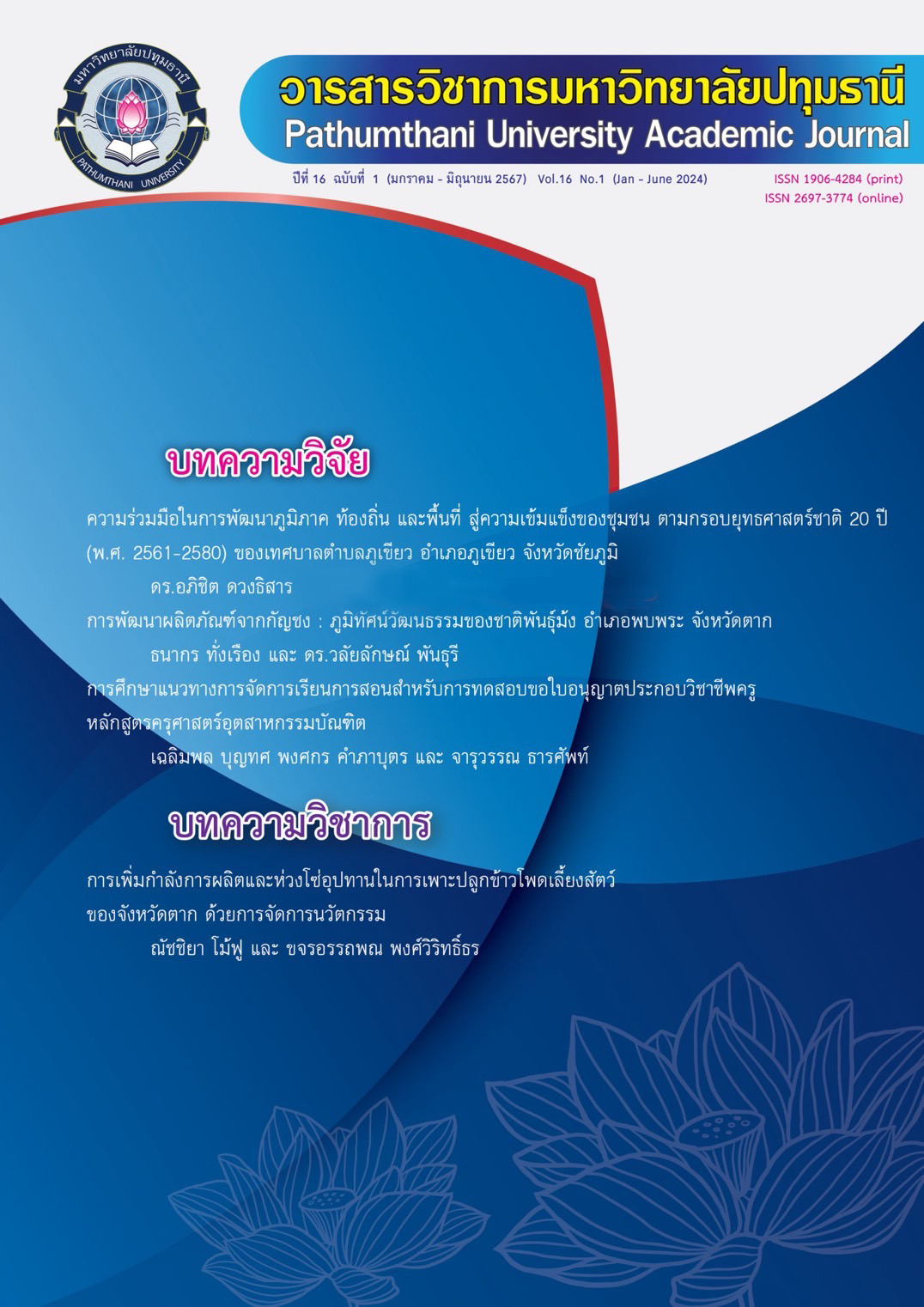HEMP PRODUCTS DEVELOPMENT: CULTURAL LANDSCAPE OF THE HMONG ETHNIC GROUP, PHOP PHRA DISTRICT, TAK PROVINCE
Keywords:
Hemp products, Cultural Landscape, Hmong Ethnic GroupAbstract
This research article aims to: Analyze the cultural landscape of the Hmong ethnic group in Phop Phra District, Tak Province. Develop hemp products from the cultural landscape of the Hmong ethnic group in Phop Phra District, Tak Province, utilizing research and development methodologies such as documentary analysis, surveys, and in-depth semi-structured interviews totaling 50 participants. Four main informant groups were selected using purposive sampling: 1) Government representatives, 2) Community leaders, 3) Entrepreneurs, and 4) Community members. A meeting was organized to facilitate knowledge exchange through participatory brainstorming to develop hemp products.
The results revealed: 1) Hemp serves as the cornerstone of the cultural landscape, representing a significant reservoir of cultural capital. The Hmong ethnic group has cultivated hemp for generations, harnessing extensive wisdom in its utilization within an agricultural context deeply ingrained in their cultural heritage. Hemp cultivation areas thus serve as the nexus of cultural production, yielding artifacts that reflect and embody the unique cultural values and identity of the Hmong ethnic group. and 2) The development of hemp-based products exemplifies the culmination of ancestral wisdom, encompassing a diverse array of items including clothing, accessories, handicrafts, and consumables such as soap, serum, face masks, and culinary products like Matcha. Each product conveys narratives, lifestyles, meanings, beliefs, and traditions, symbolizing the innovative spirit of contemporary expression. These findings hold significance for various sectors, particularly in spatial development administration, by informing strategies for policy formulation and planning that prioritize the cultural landscape's role in generating value-added cultural products and services. Such initiatives aim to align with the evolving dynamics of the modern global economy and society.
References
ทองเจือ เขียดทอง. (2558). “ผลิตภัณฑ์ผ้าปักม้ง: การออกแบบเชิงเศรษฐกิจสร้างสรรค์”. Journal Art klongHok. ปีที่ 2 ฉบับที่ 1. หน้า 55-79.
ภูมิฐวัศ สัมพันธ์พานิช. (2562). แนวทางการพัฒนาชุมชนอย่างยั่งยืน กรณีศึกษาการปลูกเฮมพ์เพื่อแปรรูปเป็นผลิตภัณฑ์ชุมชน ตำบลแม่ตาว อำเภอแม่สอด จังหวัดตาก. วิทยานิพนธ์ศิลปศาสตรมหาบัณฑิต สาขาวิชาการจัดการมรดกวัฒนธรรมและอุตสาหกรรมสร้างสรรค์. มหาวิทยาลัยธรรมศาสตร์.
ภูมิฐวัศ สัมพันธ์พานิช และกาญจน์นภา พงศ์พนรัตน์. (2562). “เฮมพ์…รากเหง้าแห่งวิถีชีวิตวัฒนธรรมชาวม้ง”. วารสารสิ่งแวดล้อม. ปีที่ 23 ฉบับที่ 3. หน้า 1-8.
ศูนย์มานุษยวิทยาสิรินธร (องค์การมหาชน). (2566). ม้งคีรีราษฎร์. [ออนไลน์]. เข้าถึงได้จาก : https://wikicommunity.sac.or.th/community/50#chck4. เข้าถึงเมื่อ 10 ตุลาคม 2566.
สุทิน เรืองปานกัน, ทรงคุณ จันทจร และระพีพันธ์ ศิริสัมพันธ์. (2565). “การศึกษาภูมิปัญญาในการผลิตเส้นใยกัญชงเชิงอุตสาหกรรมสิ่งทอชุมชน”. วารสารวิจัยธรรมศึกษา. ปีที่ 5 ฉบับที่ 2 (กรกฎาคม-ธันวาคม 2565). หน้า 17-27.
สุรศักดิ์ บุญเทียน. (2564). “การพัฒนาคนบนฐานอัตลักษณ์วิถีวัฒนธรรมม้ง กรณีศึกษาบ้านเจดีย์โคะ ตำบลมหาวัน อำเภอแม่สอด จังหวัดตาก”. วารสาร มจร การพัฒนาสังคม. ปีที่ 6 ฉบับที่ 1 (มกราคม-เมษายน 2564). หน้า 1-13.
สุดสันต์ สุทธิพิศาล. (2564). “มรดกทางวัฒนธรรม”. เอกสารประกอบการเรียนรายวิชาประเด็นและแนวโน้มการจัดการอุตสาหกรรมบริการและการท่องเที่ยว. หลักสูตรปรัชญาดุษฎีบัณฑิต สาขาวิชาการจัดการอุตสาหกรรมบริการและการท่องเที่ยว. มหาวิทยาลัยเกษมบัณฑิต.
สำนักงานคณะกรรมการพัฒนาการเศรษฐกิจและสังคมแห่งชาติ. (2565). แผนพัฒนาเศรษฐกิจและสังคมแห่งชาติ ฉบับที่ 13 พ.ศ. 2566-2570. สำนักนายกรัฐมนตรี.
อนุวัฒน์ การถัก และ ทรงยศ วีระทวีมาศ. (2558). “ภูมิทัศน์วัฒนธรรม: ความหมาย พัฒนาการทางแนวคิดและทิศทางการศึกษาวิจัย”. วารสารวิชาการคณะสถาปัตยกรรมศาสตร์ มหาวิทยาลัยขอนแก่น. ปีที่ 14 ฉบับที่ 2. หน้า 1-12.
Blij H. D., & Murphy A. B. (1977). Human Geography: Culture, Society, and Space. New York [u.a.]: Wiley.
Fuller, G.W. (2011). New Food Product Development: From Concept to Marketplace. (3rd Ed.). CRC Press.
Downloads
Published
How to Cite
Issue
Section
License
Copyright (c) 2024 Walailak Panturee

This work is licensed under a Creative Commons Attribution-NonCommercial-NoDerivatives 4.0 International License.
บทความที่ได้รับการตีพิมพ์เป็นลิขสิทธิ์ของวารสารมหาวิทยาลัยปทุมธานี
ข้อความที่ปรากฎในบทความแต่ละเรื่อง เป็นความคิดเห็นส่วนตัวของผู้เขียน กองบรรณาธิการไม่จำเป็นต้องเห็นด้วยเสมอไป และไม่มีส่วนรับผิดชอบใด ๆ ถือเป็นความรับผิดชอบของผู้เขียนแต่เพียงผู้เดียว


